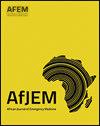Barriers to accessing appendectomy in the public sector health system in the Western Cape Province, South Africa
IF 1.2
4区 医学
Q3 EMERGENCY MEDICINE
引用次数: 0
Abstract
Background
Appendectomy is the surgical treatment for acute appendicitis and barriers to timely care can lead to morbidity and mortality. In South Africa, patients experience delays during the stages of seeking, reaching, and receiving care. This study explored the perceptions and experiences of barriers to accessing appendectomy among patients, caregivers, and surgeons employed at selected public hospitals in the Western Cape, South Africa.
Methods
A qualitative study was conducted through semi-structured in-depth interviews. Study sites comprised four public hospitals. The interviews were audio recorded, transcribed, and translated verbatim. Excerpts in the qualitative data were systematically categorised and themes were generated using inductive thematic analysis according to Braun and Clarke's methodology.
Findings
The following themes were generated from the analysis 1) barriers related to late presentation to a healthcare facility and 2) barriers related to healthcare facility delays. Identified barriers were perceptions of appendicitis-like symptoms, the influence of beliefs, customs and culture on healthcare-seeking behaviour, personal and social positions and values, lack of knowledge of the health system, transport accessibility and affordability, delayed ambulance response time, and proximity of healthcare facilities. Key barriers experienced after presentation to a healthcare facility related to inter-facility transfers, surgical capacity, and the diagnostic and management capabilities of facilities.
Conclusion
Participants in the study experienced, and perceived similar delays to accessing appendectomy to that reported in other African countries. Improved health literacy in communities could lead to timely healthcare-seeking behaviour for appendicitis and other emergency conditions. Efforts are needed to ensure access to affordable and available transport options, and healthcare facilities need to be better equipped to diagnose and treat appendicitis. This can be achieved through upskilling and augmenting human and other resources, which will require the support of the government and other relevant stakeholders.
在南非西开普省公共部门医疗系统接受阑尾切除术的障碍
背景阑尾切除术是急性阑尾炎的外科治疗方法,而及时治疗的障碍会导致发病率和死亡率。在南非,患者在寻求、到达和接受治疗的各个阶段都会遇到延误。本研究探讨了南非西开普省部分公立医院的患者、护理人员和外科医生对接受阑尾切除术的障碍的看法和经历。研究地点包括四家公立医院。对访谈进行了录音、转录和逐字翻译。根据布劳恩和克拉克的方法,对定性数据的摘录进行了系统分类,并使用归纳式主题分析法生成了主题。研究结果分析生成了以下主题:1)与延迟到医疗机构就诊有关的障碍;2)与医疗机构延误有关的障碍。确定的障碍包括对阑尾炎症状的看法、信仰、习俗和文化对就医行为的影响、个人和社会立场及价值观、对医疗系统缺乏了解、交通便利性和经济承受能力、救护车响应时间延迟以及医疗机构的距离。到医疗机构就诊后遇到的主要障碍涉及医疗机构之间的转院、手术能力以及医疗机构的诊断和管理能力。提高社区居民的健康素养可促使人们及时寻求阑尾炎和其他急症的医疗服务。需要努力确保人们能够使用负担得起且可用的交通工具,医疗机构也需要更好地配备诊断和治疗阑尾炎的设备。这可以通过提高技能和增加人力及其他资源来实现,而这需要政府及其他相关利益方的支持。
本文章由计算机程序翻译,如有差异,请以英文原文为准。
求助全文
约1分钟内获得全文
求助全文
来源期刊

African Journal of Emergency Medicine
EMERGENCY MEDICINE-
CiteScore
2.40
自引率
7.70%
发文量
78
审稿时长
85 days
 求助内容:
求助内容: 应助结果提醒方式:
应助结果提醒方式:


